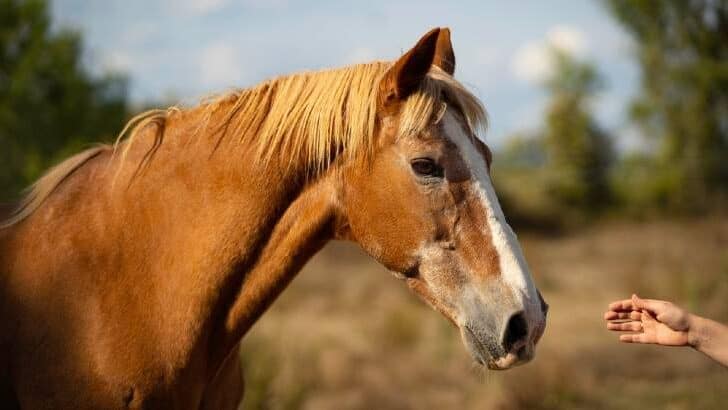Affiliate Disclaimer
As an Amazon Associate I earn from qualifying purchases. It helps me keep the website going. Thank you for your support.
Should you, or can you, ride a horse with arthritis? Well, it rather depends on who has arthritis – you or the horse! If it’s you, then yes, you can still enjoy your favorite pastime, although you may need to support those aching joints in some way. If your horse has arthritis, it depends…
The good news is that often you can ride a horse in the early stages of arthritis. In fact your horse will benefit from light, regular exercise. However, you may need to modify your riding and equipment as appropriate. As arthritis progresses though, it will become more difficult and painful for it to be ridden.
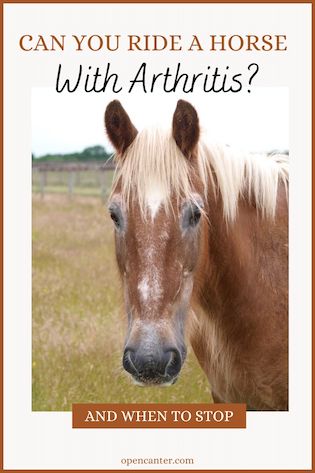
But first, a bit about the skeleton of the horse…
Arthritis And Skeletal Development In The Horse
In older equines, particularly those that have led an active sporting life, arthritis is a common outcome of the wear and tear their joints have been exposed to over the years. However, when it develops in young horses, it can often be the result of unnatural stresses on immature parts of the skeleton, notably the spine.
All bones in a horse, apart from the skull, have growth plates on each end so they can lengthen as the horse grows. Some parts of the skeleton also mature earlier than other parts, and the growth plates in that area then fuse.
This process starts at birth and finishes around 6 years of age. It also starts from the bottom up.
- Year 1 – the pastern, fetlock, and cannon bones reach their mature length and size
- Year 2 – the growth plates in the knees and hocks close
- Year 3 – the main forearm, hock, and thighbones reach their mature length
- Year 4 – the shoulder bone finishes growing
- Year 5 – the pelvic bone stops growing
- Year 6 – the spine is the last part of the skeleton to stop growing, and finally matures at 6
Significantly, the vertebrae just behind the poll, at the base of the neck and through the wither are the very last to fuse. In some big breeds (i.e. warmbloods), this takes longer than in others.
Arthritis Affects More Than the Leg Joints
When people think of arthritic horses, they often think of puffy, knobbly leg joints. These joints, particularly in the front legs, are certainly prone to developing arthritis as they bear most of the horse’s weight. However, arthritis can also develop in the spine and hips.
This is particularly common in racehorses that are extensively ridden before their spine and pelvic bones are anywhere near fully mature. Indeed, when you think about it, many racehorses have already retired before their spine matures!
Unfortunately, arthritis in the pelvic and spinal joints is often not noticed until the horse develops a markedly unusual way of moving or becomes sore under saddle. X-rays and autopsies on horses with spinal and pelvic arthritis invariably show misalignment and abnormal wear in these bones.
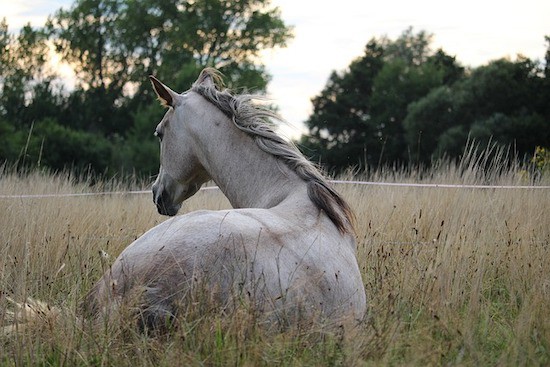
Causes Of Arthritis In Horses
Horses most commonly develop osteoarthritis (OA). This is a painful, degenerative joint disease that affects both humans and animals. It is, in fact, one of the leading causes of lameness in horses, accounting for approximately 60% of cases.
Osteoarthritis ordinarily affects older equines from their mid-teens upwards. However, young ones can also develop it under the right circumstances, such as injury or infection in a joint.
The disease may be caused by a range of things, the most common of which are:
- Wear and tear on the joints
- Injury, or
- Infection
Development Of Osteoarthritis In Horses
Osteoarthritis occurs when tissues in the joint, notably the protective articular cartilage on the end of the bones, break down. Without ‘padding’ between them, the bones start to grind against each other, leading to inflammation and eventual destruction of the joint. If left untreated, it will have a debilitating effect on a horse’s long-term health and wellbeing.
Osteoarthritis is not curable. Rather, the treatment goal is to slow its progress. However, even with the best treatment, OA can still cause immense discomfort for the horse as it progresses. It’s therefore important, as an owner, to learn to recognise the signs and take steps to minimise the discomfort for the horse.
Common Symptoms of Arthritis In Horses
Symptoms of arthritis in horses can range from subtle to severe and often includes:
- Lameness
- Stiffness
- Decreased performance
- Changes in behaviour
- Swelling in the joints, which may become hot and painful
- Difficulty getting up as the disease progresses
Can You Ride A Horse With Arthritis?
Although you can ride a horse that has been diagnosed with arthritis, you do need to factor this into your riding. Be aware of the signs and symptoms of the disease. Know how your horse exhibits pain, and manage its workload appropriately. Understand that behavioural and performance issues can be an indication of discomfort or pain, and may indicate the arthritis is getting worse.
If you compete, this may mean scaling back your competition riding or ending it altogether with this particular horse. Realistically, if it requires pain medication or drugs like corticosteroids to manage the condition, it’s a safe bet it shouldn’t be competing. Quite apart from the humane considerations, anti-inflammatory drugs are banned in most competitions.
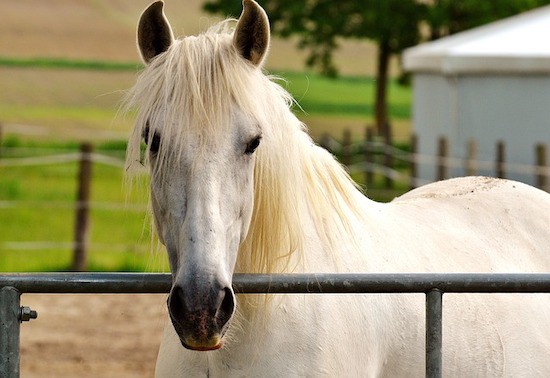
Caring For A Horse With Arthritis
If your horse develops arthritis, get yourself a good vet, and be aware of the most common, available treatments. Your number 1 priority in caring for the horse is making sure it’s comfortable. When this is no longer feasible or possible, arrange to have it put down humanely.
In the meantime, there are many things you can do, and use, to provide support to an arthritic horse. This includes:
- Providing a safe and comfortable environment (plenty of turnout, no bullying paddock companions)
- Changes in nutrition and diet (consider consulting an equine nutritionist, keep an open mind about herbal products)
- Specialised joint supplements
- Good hoof care
- Supportive equipment like tendon boots (magnetic boots and rugs may help some horses)
The Importance of Exercise For The Arthritic Horse
Regular exercise is key to successfully managing a horse with arthritis. In particular, make sure it gets enough turnout time, or light work. Low-impact activities like walking, slow trotting, and riding on even, level terrain, are ideal. Avoid hard surfaces like sealed roads and pavements because they are not kind to arthritic joints.
Movement helps prevent joints from stiffening up, thereby reducing inflammation and pain. Exercise helps keep the horse’s muscles strong and flexible. This assists with supporting affected joints and aids in relieving some of the pain. The overall goal is to improve joint flexibility, range of motion, and strength, without making the horse uncomfortable.
Diet And the Arthritic Horse
Along with a regular ride and exercise, diet plays a big role in supporting a horse with arthritis. Ensuring it gets a balanced diet tailored to its specific needs can make a significant difference to the pain and inflammation. This may mean looking into products like joint supplements, identifying and removing pro-inflammatory components of the diet, and considering natural anti-inflammatories.
When it comes to equine joint support products, there are plenty on the market. In most cases, they are a balanced blend of essential nutrients and compounds that help promote joint health. However, not all horses respond the same way to these products. What works well for one individual may have little to no effect on another. It’s therefore advisable to try a few and see which ones work, and which ones don’t.
Remove or reduce pro-inflammatory feeds in the diet. Omega-6 fatty acids for example are amongst the highest sources of pro-inflammatory compounds in the average equine diet. They are found in cereal grains (oats, wheat, barley etc); in sunflower seeds and oils; and in corn (maize) and corn oil. Swap the oils (if you feed them) for ones with higher omega 3 content (canola, flaxseed), reduce the grains, and increase forage content.
Talk to a nutritionist or equine naturopath about natural plant compounds that can help with inflammation. Turmeric for example contains high levels of curcumin, a proven natural anti-inflammatory.
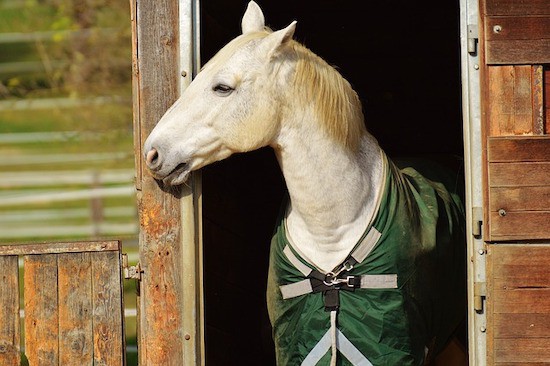
Pain Management for Equine Arthritis
In its early stages, arthritis can often be managed with diet, joint supplements, and exercise. However, as the disease progresses your vet may prescribe corticosteroid joint injections. Corticosteroids are powerful anti-inflammatory drugs commonly used to treat a variety of inflammatory diseases like arthritis.
Pentosan™ is another common prescription drug for arthritic horses. It is administered via intramuscular injection and reduces inflammation. At the same time, it also stimulates cartilage production, which aids in repairing and protecting joints. Pentosan incidentally is not a corticosteroid but a “pentasaccharide heparinoid” extracted from European Beechwood.
Your vet will determine which treatment options are most appropriate for the horse. They should also provide you with a tailored overall treatment plan based on your horse’s individual needs.
The Importance Of Good Hoof Health For a Horse With Arthritis
Good hoof health and regular trimming are also of utmost importance for horses with arthritis, both for helping prevent it and for horses that have it.
When hooves are correctly balanced, the joints, tendons and ligaments in the leg can move normally. When they are not, this symmetry is altered and the distribution of force and weight across the joints becomes unbalanced. This results in uneven movement and wear in the joints, eventually leading to arthritic changes.
The Importance Of Your Vet
Ultimately, it’s always best to talk to your vet before deciding whether an arthritic horse can be ridden, or is safe to ride. If you are thinking of buying a horse with arthritis, be sure to ask the vet to evaluate this in the pre purchase exam. Furthermore, appropriate management at the onset of arthritis will slow down the damage and allow you to better maintain his or her quality of life.
Final Thoughts
Can you ride a horse with arthritis? In the early stages of the disease, light riding or exercise is often beneficial. It can help keep their joints supple and their muscles toned. However, it is important you remain aware of the signs and symptoms of the disease and manage its workload appropriately.

